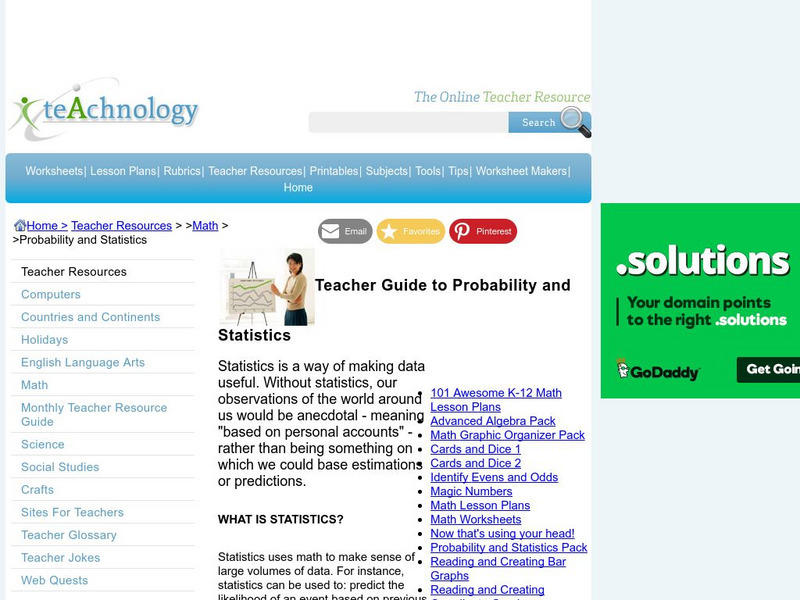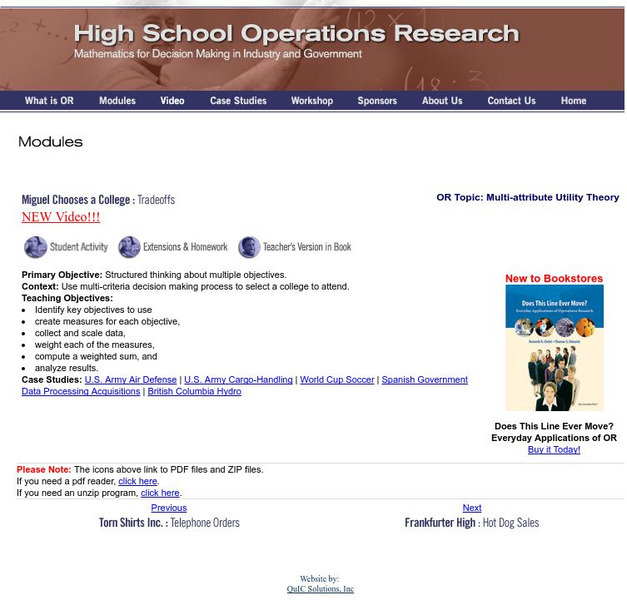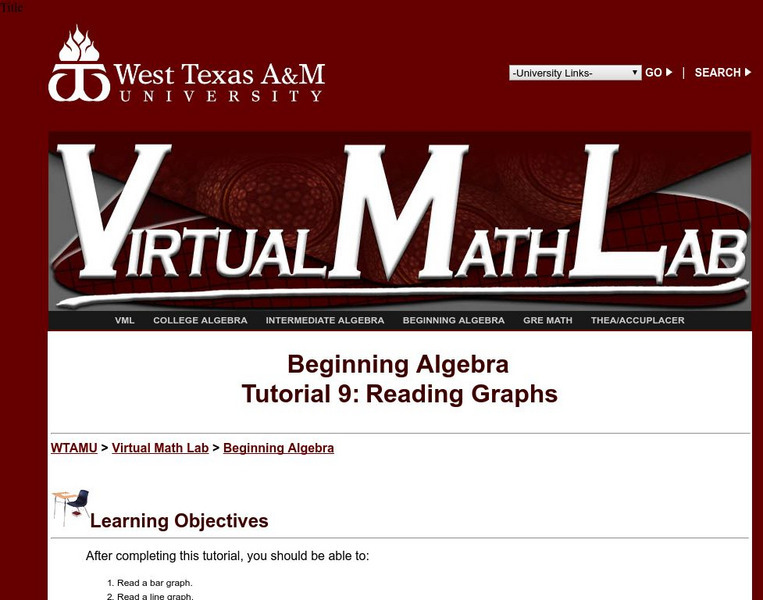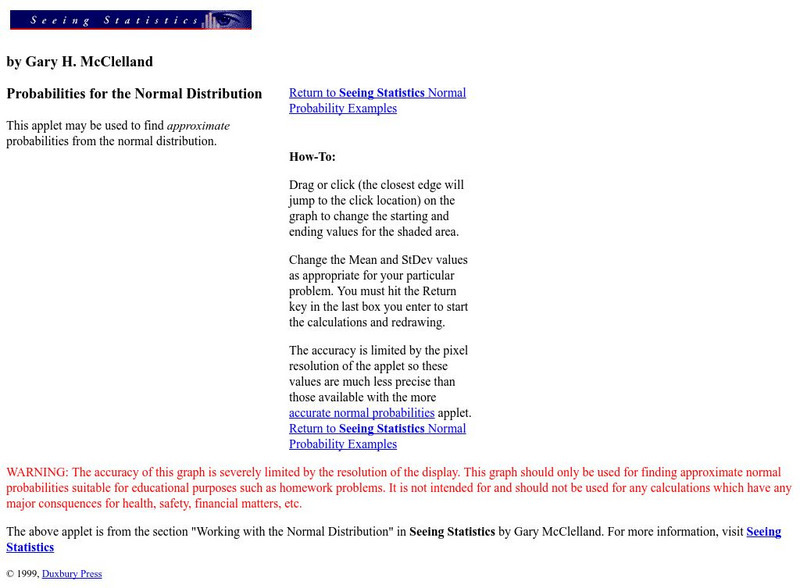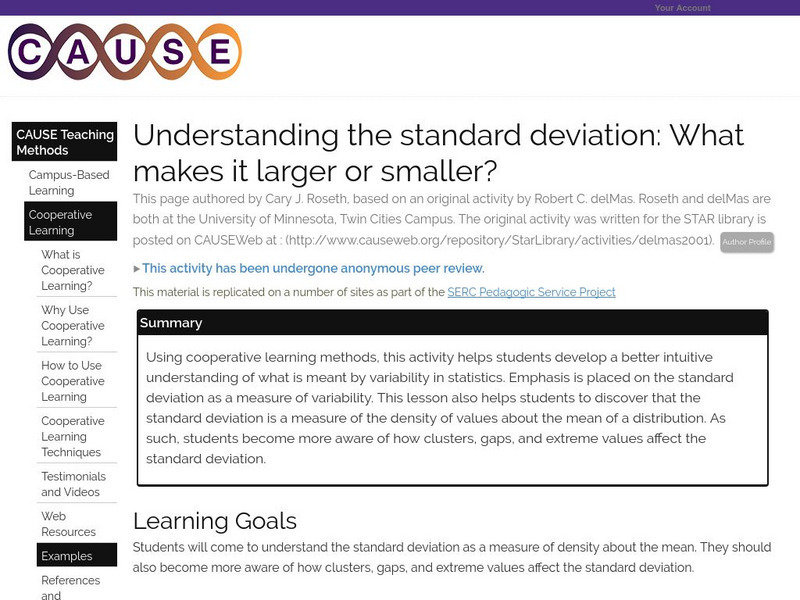Hi, what do you want to do?
Hofstra University
Hofstra University: Review Exercises Random Variables..
Interactive review problems are offered to practice the concepts of random variables and statistics. Topics covered include, Bernoulli trials, normal and binomial distributions, Chebyshev's rule, and the like.
Teachnology
Teachnology: Teacher Guide to Probability and Statistics
Statistics Theme provides a collection of free sample worksheets, teacher resources, lesson plans and interactive media for grades k-12.
Texas Instruments
Texas Instruments: Using the Ti 83/84 to Explore the Binomial Theorem
This lesson will introduce students to the binomial theorem through a variety of activities. Pascal's triangle and probabilities will be explored through problem solving. The binomial theorem, combinations formula, and the binomial...
CK-12 Foundation
Ck 12: Algebra: Fitting Lines to Data
[Free Registration/Login may be required to access all resource tools.] Make a scatter plot of data and find the line of best fit to represent that data.
Khan Academy
Khan Academy: Fitting Quadratic and Exponential Functions to Scatter Plots
Determine if a quadratic or exponential model fits a data set better, then use the model to make a prediction. Students receive immediate feedback and have the opportunity to try questions repeatedly, watch a video or receive hints.
Other
Hsor.org: Miguel Chooses a College: Tradeoffs
Use several strategies and criteria to help Miguel determine the college for him.
National Council of Teachers of Mathematics
Nctm: Illuminations: Advanced Data Grapher
The Advanced Data Grapher can be used to analyze data with box plots, bubble graphs, scatterplots, histograms, and stem-and-leaf plots.
Texas A&M University
Wtamu Virtual Math Lab: Beginning Algebra: Reading Graphs
A good introduction to reading bar, line, and double line graphs, and drawing and reading Venn diagrams. Contains definitions and examples of these types of charts and graphs as well as practice exercises that ask you to answer questions...
Alabama Learning Exchange
Alex: My Peanut Butter Is Better Than Yours!
The students will engage in the process of statistical data comparing data using tables and scatterplots. The students will compare data using measures of center (mean and median) and measures of spread (range). This lesson can be done...
Alabama Learning Exchange
Alex: Let's Make a Pie
The students will survey their classmates and construct circle graphs to display their results. Students will produce circle graphs using a compass and protractor, and then with an interactive computer program.This lesson plan was...
University of Colorado
University of Colorado: Normal Probabilities Applet #2
This Applet allows the user to grab and drag the ends of the included region below the standard normal curve to the appropriate places needed. The user directly experiences the connection between the shaded area under the curve and the...
Other
Aus Race: Odds, Statistical Probability and Gambling
This interesting article explains gambling (both horse racing and casinos) in terms of probability. It takes a common sense approach, instead of a mathematical approach, to the topic.
California State University
Cal State San Bernardino: Intro to Probability Models
The concept of random variables comes to life with this Applet used to roll one, two, six, or nine dice. The user selects the number of rolls to be completed, and the program quickly counts and graphs the results.
University of Glasgow
Steps Statistics Glossary: Sampling Distribution
This site provides an overview of sampling distribution and associated terms.
University of Glasgow
Steps Statistics Glossary: Normal Distribution
Overview of normal distribution, including the normal distribution model, the probability density function, and standard normal distribution. The parameters for "normal" distribution are provided.
The Franklin Institute
A Penny Flipped Is Science Learned
What is the probability that a penny will land on heads when flipped? Test this on Ben Franklin's birthday and find out!
Oswego City School District
Regents Exam Prep Center: Mutually Exclusive Events
Use this site to learn what is means for two events to be mutually exclusive. Great examples show you how to calculate the probability of such events.
Illustrative Mathematics
Illustrative Mathematics: S Cp Breakfast Before School
On school days, Janelle sometimes eats breakfast and sometimes does not. After studying probability for a few days, Janelle says, "The events 'I eat breakfast' and 'I am late for school' are independent." Explain what this means in terms...
Ministry of Education and Universities of the Region of Murcia (Spain)
Ministerio De Educacion Y Ciencia: El Azar Y La Probabilidad.
In Spanish. This is an interactive activity which introduces the basic concepts of probability theory. This unit ends with a first look at the probability of compound events.
University of Baltimore
University of Baltimore: Geometric Mean
A complete definition of geometric mean in the statistical concept of the word. The discussion includes several examples of how geometric means are calculated and how/where they are useful. Written by Dr. Hossein Arsham.
Science Education Resource Center at Carleton College
Serc: Understanding the Standard Deviation: What Makes It Larger or Smaller?
Students develop a better intuitive understanding of what is meant by variability in statistics. Emphasis is placed on the standard deviation as a measure of variability.
National Council of Teachers of Mathematics
The Math Forum: Traffic Jam Activity Lesson Plan
There are seven stepping stones and six people - three on the left facing the three on the right. How is it possible to have the three on the left end up on the right, and vice versa, while everyone was at all times standing on a stone...
Khan Academy
Khan Academy: Markov Chains
The concept of modeling sequences of random events using states and transitions between states became to known as Markov Chains. Introduction to Markov chains. Created by Brit Cruise.
Oswego City School District
Regents Exam Prep Center: Mutually Exclusive & Independent Events
The somewhat tricky differences between mutually exclusive, non-mutually exclusive, independent, and dependent events are defined here. Common items such as coins, colored cubes, and a deck of cards are all part of the easy-to-understand...






